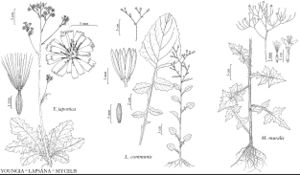Lapsana
Sp. Pl. 2: 811. 1753.
Gen. Pl. ed. 5, 353. 1754.
| Taxon | Illustrator ⠉ | |
|---|---|---|
 | Youngia japonica Lapsana communis Mycelis muralis | Yevonn Wilson-Ramsey Bee F. Gunn Marjorie C. Leggitt |
Annuals [biennials], 15–150 cm; fibrous-rooted. Stems 1, erect, simple or branched, glabrate to sparsely or densely pilose, hairs often stipitate-glandular. Leaves basal and cauline (not in rosettes); narrowly winged-petiolate; blades ovate to suborbiculate (thin), margins entire, dentate, or lyrate-pinnatifid proximally (terminal lobes larger than laterals, faces glabrate to sparsely hirsute; distal sessile, lanceolate, reduced). Heads in open, corymbiform to thyrsiform arrays. Peduncles (slender) slightly inflated distally, ebracteate. Calyculi of 4–5 subulate or scalelike, glabrous bractlets. Involucres cylindric to campanulate, 2–5 mm diam. Phyllaries 8–10 in 1 series, linear-oblong, subequal, (strongly keeled) margins green, not scarious, apices acute, faces glabrous. Receptacles flat, smooth, glabrous, epaleate. Florets 8–15; corollas yellow. Cypselae dimorphic (outer much longer than inner), tan to golden brown, subcylindric, curved, terete to slightly compressed, not beaked, ± 20-ribbed, glabrous; pappi 0. x = 7.
Distribution
Introduced; Europe, Asia
Discussion
Species 1.
Lapsana formerly included about 9 species, some from eastern Asia. Based on cladistic analysis of morphologic characters, the eastern Asian species have been removed to Lapasanastrum, a strongly supported monophyletic group characterized by spreading phyllaries and distinctive fruit anatomy (J. H. Pak and K. Bremer 1995).
Selected References
Lower Taxa
"fine" is not a number.